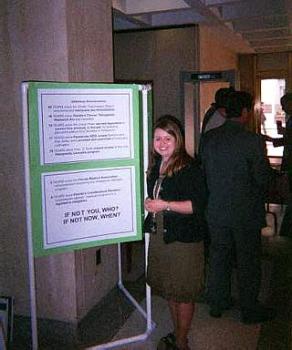Reentry/Rehabilitation
Growth of Ex-Offender Population in United States Is a Dramatic Drag on Economy (Press Release)
For Immediate Release:November 15, 2010
Contact: Alan Barber, (571) 306-2526
Washington, D.C.- Three decades of harsh criminal justice policies have created a large population of ex-offenders that struggle in the labor market long after they have paid their debts to society, according to a new report from the Center for Economic and Policy Research (CEPR). Because prison records and felony convictions greatly lower ex-offenders' chances of finding work, the United States loses between $57 billion and $65 billion a year in lost output.
“It isn't just that we have the highest incarceration rate in the world, we have created a situation over the last 30 years where about one in eight men is an ex-offender,” said John Schmitt, a Senior Economist at CEPR and a co-author of the report.
The new report, “Ex-offenders and the Labor Market,” found that in 2008 there were between 5.4 million and 6.1 million ex-prisoners and between 12.3 million and 13.9 million ex-felons in the United States. Over 90 percent were men.
In 2008, about one in 33 working-age adults was an ex-prisoner, and about one in 15 working-age adults was an ex-felon. Among working-age men in that same year, about one in 17 was an ex-prisoner and one in eight was an ex-felon.
Because ex-offenders face substantial barriers to employment, the authors estimate that the large ex-offender population in 2008 lowered employment that year by the equivalent of 1.5 million to 1.7 million workers.
"The rise in the ex-offender population overwhelmingly reflects changes in the U.S. criminal Justice system, not changes in underlying criminal activity," says Schmitt. "We incarcerate an astonishing share of non-violent offenders, particularly for drug-related offenses. We have far better ways to handle these kinds of offenses, but so far common sense has not prevailed."
The report warns that in the absence of reforms to the criminal justice system, the share of ex-offenders in the working-age population will rise substantially in coming years, increasing the magnitude of employment and output losses estimated for 2008.
###
The Republican House and Drug Reform: The Good, the Bad, and the Ugly [FEATURE]
Rockefeller Repeal Leader Wins NY Democratic AG Nomination
Veteran Drug Reformer Wins Florida House Primary
Second Chance Conference Website Released
Â
Â
|
Your Ideas on Prison/Reentry Needed by Candidate for Georgia Governor
|
Senate Passes Second Chance Act, Awaits President's Signature
[Courtesy of The Sentencing Project]
    Â
    The Senate passed the Second Chance Act of 2007 late Tuesday, which will ease the re-entry process for individuals leaving prison by providing funding for prisoner mentoring programs, job training and rehabilitative treatment. The legislation, introduced in the Senate by Sens. Joseph Biden (D-DE), Patrick Leahy (D-VT), Arlen Specter (R-PA) and Sam Brownback (R-KS), now awaits approval by President Bush - who in his 2004 State of the Union address advocated for a $300 million Prisoner Re-entry Initiative. Â
    The legislation was passed by a voice vote after the Senate adopted a concurrent resolution, H Con Res 270, which included minor changes to the measure. The U.S. House of Representatives voted 347 to 62 to pass the Second Chance Act of 2007 in November.
    The Second Chance Act will help provide necessary services to the nearly 700,000 people leaving prison each year by increasing funding designed to protect public safety and reduce recidivism rates. The bill's provisions authorize $362 million to expand assistance for people currently incarcerated, those returning to their communities after incarceration, and children with parents in prison. The services to be funded under the bill include:
- mentoring programs for adults and juveniles leaving prison;
- drug treatment during and after incarceration, including family-based treatment for incarcerated parents;
- education and job training in prison;
- alternatives to incarceration for parents convicted of non-violent drug offenses;
- supportive programming for children of incarcerated parents; and early release for certain elderly prisoners convicted of non-violent offenses.
    The reform bill was widely supported by civil rights, criminal justice, law enforcement and religious organizations and had broad bipartisan support in both the Senate and House of Representatives.




 Â
Â